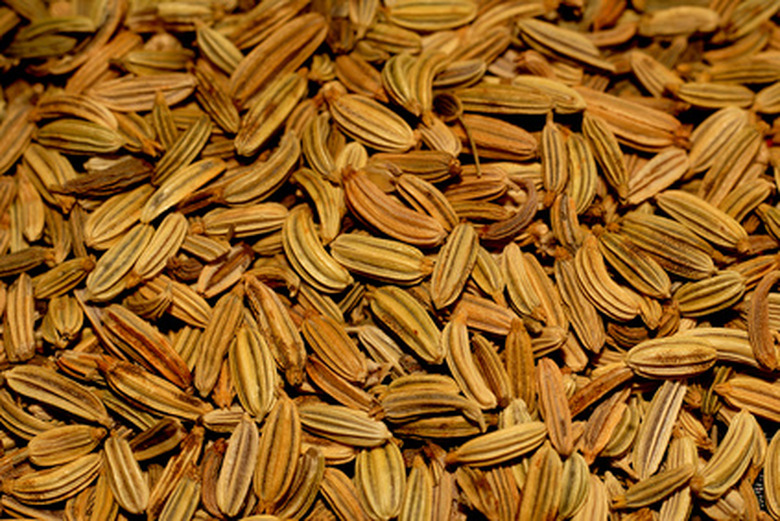How To Trim Fennel
All parts of fennel plants are used in cooking. The bulb and stalks are sliced and added to soups or other recipes as a vegetable, while the leaves are an edible garnish. Fennel seeds are a common spice found in most grocery stores. All parts of the plant have a slight peppery taste, with the stalks being similar to celery. Trimming either the whole fennel plant or just the stalks ensures you get the most use out of this adaptable plant.
Step 1
Cut the stalks off at the soil level if you are leaving the bulbs in the ground. Otherwise, dig up the entire bulb and bring the whole plant inside.
- All parts of fennel plants are used in cooking.
- The bulb and stalks are sliced and added to soups or other recipes as a vegetable, while the leaves are an edible garnish.
Step 2
Rinse any dirt or debris off the fennel in cool, running water. Trim off any roots attached to the bulb with a sharp knife.
Step 3
Cut the stalks off the bulb if you harvested the entire plant. Trim the feather-like leaves off the top of each stalk then cut the stalks into small slices.
Step 4
Cut off the root end of the fennel bulb. Slit one side of the fennel bulb with a knife and peel of the layer, similar to peeling an onion.
Step 5
Cut the bulb into quarters or into slices, depending on what your recipe calls for. Store the trimmed bulbs, stalks and leaves in the refrigerator for five to seven days.
- Rinse any dirt or debris off the fennel in cool, running water.
- Cut the stalks off the bulb if you harvested the entire plant.
Fennel Is Ripe
Sweet fennel (Foeniculum vulgare, hardy in U.S. Department of Agriculture plant hardiness zones 4 through 9) provides seeds and leaves for the kitchen, but Florence fennel (Foeniculum vulgare var. azoricum, hardy in USDA zones 5 through 9) is usually grown for its bulbous, edible base. The kitchen gardener can choose from sweet fennel, Florence fennel and bronze fennel (Foeniculum vulgare 'Purpureum', hardy in USDA zones 4 through 9), among other varieties, to grow in the veggie patch or herb garden. Sweet, bronze and Florence fennel look similar, too. Sweet and Florence fennel leaves are yellow-green, and bronze fennel's leaves are purple-bronze. Bronze fennel sits in between, growing 3 to 5 feet tall and 2 to 3 feet wide, and it also doesn't form Florence fennel's bulb. Florence fennel bulbs should be harvested when they're the size of a small fist or a tennis ball. The bulbs form best in cool temperatures and take about three weeks from when they begin to form to grow to harvest size. Don't delay harvesting Florence fennel bulbs. Wait until just before the flowers are about to open in mid- to late-summer before harvesting flower stalks. Harvest fennel leaves, shoots, seeds and bulbs by cutting the stems with pruning shears, and digging up the bulbs. Dried fennel leaves lose their flavor. For a regular supply of fresh **fennel shoots,** grow five or plants when they're established, and cut all the stems of one or two of them to ground level. Snip the stems below the dry flowers, and place the flowers on a tray in a warm, dry place to finish drying out before storing them in an airtight container. Fennel grows best from seeds sown directly into the soil. Florence fennel seeds should be sown in mid-summer to avoid the risk of having the plants flower before the bulbs are formed. Rows of fennel should be spaced 24 inches apart. In windy spots, you may need to stake fennel plants. Their tall, feathery foliage makes them susceptible to being blown over, especially when they're grown in rich soil, which produces tall plants. Tie the twine to the stake.
- Sweet fennel (Foeniculum vulgare, hardy in U.S. Department of Agriculture plant hardiness zones 4 through 9) provides seeds and leaves for the kitchen, but Florence fennel (Foeniculum vulgare var.
- In windy spots, you may need to stake fennel plants.
- Their tall, feathery foliage makes them susceptible to being blown over, especially when they're grown in rich soil, which produces tall plants.
Tip
Fennel bulbs are sometimes called sweet anise. You can trim off leaves or single stalks from fennel plants as they are needed without damaging the bulb. The bulb will continue to grow.
References
- Washington State Extension: Fennel
- Missouri Botanical Garden: Foeniculum Vulgare
- Missouri Botanical Garden: Foeniculum Vulgare Var. Azoricum
- University of Wisconsin-Madison Master Gardener Program: Fennel, Foeniculum Vulgare
- University of Arkansas Division of Agriculture: Fennel
- Plants For a Future: Foeniculum Vulgare
- Missouri Botanical Garden: Foeniculum Vulgare 'Purpureum'
